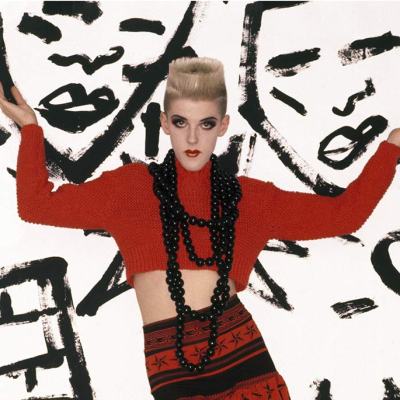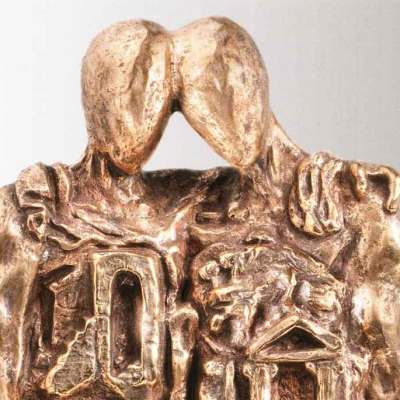In the early 1920s, Giorgio de Chirico produced an arresting self-portrait, in which his face is rendered naturalistically, whilst his torso and arms are painted in muted greys as if made of stone. Depending on your interpretation, he is either a man undergoing a slow process of petrifaction, or a statue being brought miraculously to life. Judging from his expression, I’d put my money on the former.
Hector and Andromache (1942), Giorgio de Chirico Private collection. Courtesy Galleria d’Arte Maggiore, Bologna

This heavily symbolic use of sculpture is a familiar trope running through de Chirico’s best-known paintings from his early metaphysical period, in which classical statuary or faceless, mannequin-like sculptures (or both) are depicted in otherwise deserted piazzas, lending an uncanny atmosphere to the works that was so beloved of the Surrealists.
What is less familiar to many people is that de Chirico also produced sculptures, and it is this that the Estorick Collection’s current show, ‘Giorgio de Chirico: Myth and Mystery’ seeks to redress. The relatively small display focuses on de Chirico’s three-dimensional works but also includes a number of paintings that explore and echo the same themes.
The Disquieting Muses (1968), Giorgio de Chirico Private collection. Courtesy Galleria d’Arte Maggiore, Bologna

The 20-odd sculptures, produced late in de Chirico’s life in the 1960s–70s, breathe three-dimensional life into figures depicted in his pre-1918 paintings such as The Disquieting Muses and Hector and Andromache (later versions of which are on display in the exhibition). His characters include gleaming faceless mannequins, swathed in classical drapery; cyborgian-looking heroes of Greek mythology, reminiscent of Epstein’s terrifying Rock Drill torso; mournful-looking eviscerated figures whose innards have been replaced by classical architectural features (no wonder they look mournful).
De Chirico wrote of the peculiar power of sculpture, which could be transformed depending on its location; in a museum setting, he observed, sculpture could surprise us with its ghostly, phantasmal presence. But ‘to discover newer and more mysterious aspects we must have access to new combinations.’ It is precisely such combinations in de Chirico’s paintings, of empty neo-classical piazzas with their subverted perspective, geometric rigour and apparently unconnected objects (sculptures and bananas, for example) that make for their disturbing uncanny atmosphere.
Ippolito (Greek Ephebe on Horseback) (1973), Giorgio de Chirico Private collection. Courtesy Galleria d’Arte Maggiore, Bologna

However, his sculptural works seem to be robbed here of their capacity to unnerve. Although many undeniably possess the quality of strangeness, these lustrous figures have little of the unsettling power of their two-dimensional counterparts. Moreover, the paintings’ conjunction of myth and modernity, which provide such a melancholy reflection on the latter, are lost when the sculptures are transposed from the depicted settings.
Their burnished, Brancusi-esque beauty is undeniable, but I found little to move me amongst them, save The Disquieting Muse (The Muses), two faceless mannequins that seem, by the subtlest tilt of the head, to be locked in some kind of earnest conversation, creating a poignant disjunction between their featureless, lifeless faces and the apparent intimacy between them. There are three lovely small bronzes of horses, whose naturalistic modelling makes for a delightful poignancy mirrored in the painting Horses at the Seashore, displayed nearby.
St George and the Dragon (1950s), Giorgio de Chirico Private collection. Courtesy Galleria d’Arte Maggiore, Bologna

Another highlight is also amongst the paintings, although it is little more than a sketch: the size of a large postcard, St George and the Dragon is a vivid, lively watercolour fizzing with delightful spontaneity in its brushwork. This single work contains all the ‘magic and surprise’ promised by the exhibition, which the sculptures, for me, sadly failed to deliver.
‘Giorgio de Chirico: Myth and Mystery’ is at the Estorick Collection, London, until 19 April 2014.



